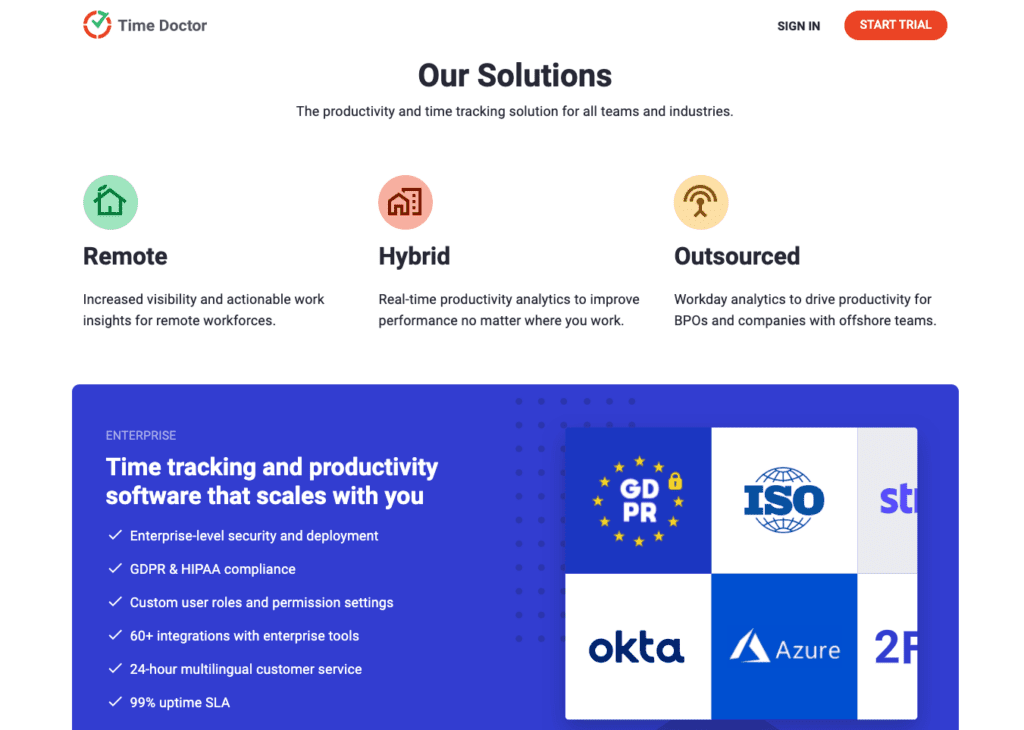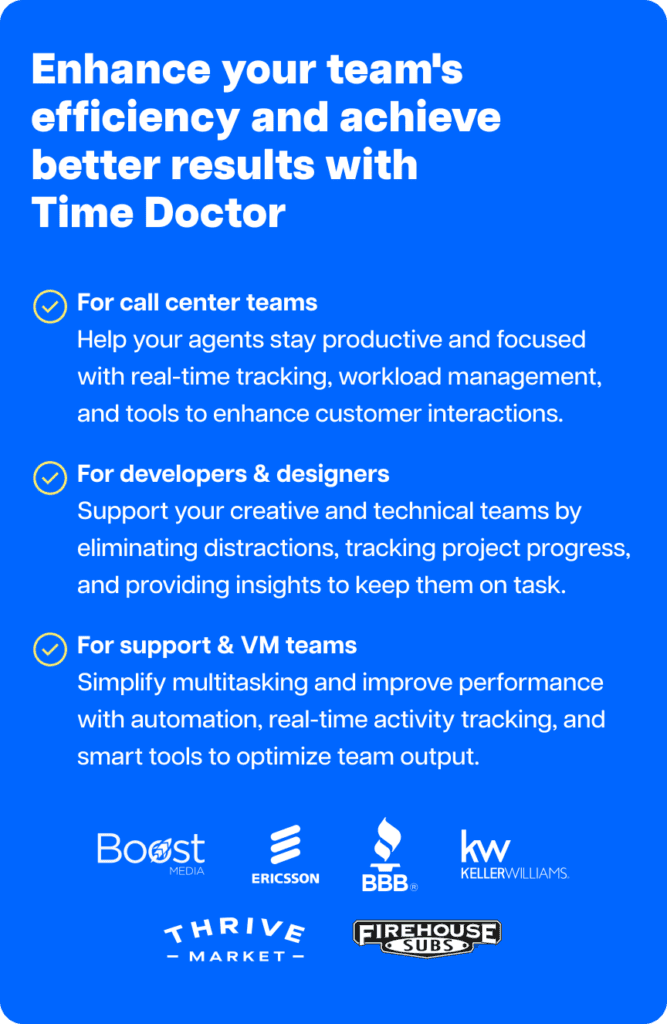From remote help desk agents to providers specializing in artificial intelligence, outsourcing computer services have grown immensely over the last decade.
For businesses that don’t revolve around IT, it’s the perfect approach to keep costs low and increase business efficiency.
However, IT outsourcing comes with its fair share of problems.
In this article, we’ll cover the top ten mistakes to avoid when outsourcing computer services. We’ll briefly touch on these easily avoidable outsourcing mistakes – and then give you insight into a tool you can use to measure the performance of your outsourcing team.
Let’s jump in.
Table of Contents
- Top 10 mistakes to avoid when outsourcing computer services
- A tool to help you measure service provider performance: Time Doctor
Top 10 mistakes to avoid when outsourcing computer services
Computer services outsourcing refers to companies outsourcing their IT-related functions to a third-party provider.
This includes everything from outsourcing simple tasks like an IT helpdesk or more complicated business processes like automation and artificial intelligence.
Here are the most common outsourcing mistakes businesses make.
1. Hiring companies that don’t know about your industry
Every project manager knows how important it is to gauge a service provider’s technical skill level before handing them your outsourced IT services.
However, even the best software development professionals can fluster when presented with problems unique to your industry. Hiring an outsourcing team without insider knowledge of your industry can be a bigger mistake than not hiring the right IT service provider.
So, before you outsource IT projects like mobile app development, check whether the outsourcing team has experience in your field – especially if your business is in an industry like medicine or accounting and financial services.
This will help you save a lot of time and money in the long run – and you won’t have to worry about long onboarding processes, undelivered goals, or unclear communication.
2. Not hiring the right service providers for your needs
Since IT outsourcing has been around for some time, most businesses are spoilt for choice when picking out a service provider.
However, this can be a problem since almost every small business tends to outsource to the most popular or cheapest provider without considering their requirement.
This leads to misunderstandings down the road and may even cause businesses to keep switching every outsourced team without ever addressing the root cause.
What works for a competing firm may not necessarily work out for you, so you first need to understand your approach to outsourcing.
Figure out if your requirement is a short-term software development project or a more permanent outsourcing solution. Then, start the selection process with a few software development providers specializing in your industry – study their business model and check case studies thoroughly to see if they fit your requirement.
Once you complete your due diligence, you can contact the provider and start the process of outsourcing software development and other IT services.
3. Outsourcing core competencies
If your core business function is custom software development and you outsource it, you essentially lose control of the daily operations of your business.
Businesses should only outsource non-essential services – which saves resources to improve their core competencies further.
Regardless of the technical skill level of your service provider, outsourcing core functions will cause communication, execution, and strategy-related problems.
Remember, your core functions need constant innovation to stay on top of the competition. If you outsource your core competencies, you’ll have to rely on your software development provider for innovation – which is rarely successful.
Your relationship with customers will be negatively affected due to changes in quality, and your business’s sensitive data may even be leaked to unauthorized persons.
Always remember to retain core functions in-house and only outsource supportive services. This way, you can retain control of everything essential to keep your business running.
4. Improper communication infrastructure
Businesses often prioritize factors like technical skill level and budget when outsourcing software development or quality assurance testing. While these are important considerations, they won’t benefit your business if the outsourcing team has poor customer service and provides no clear communication.
Communication problems can occur in every part of your relationship with the outsourcing company – from misunderstandings about the contract to irregular updates about the project.
The problem with most communication issues?
They only come up after the client realizes the results aren’t what they expected.
To prevent this, figure out how communication will work with your outsourcing provider before you sign the contract. Consider factors like time differences and language issues, avoid ambiguous clauses in the agreement and look into their customer support track record.
You can also set up daily and weekly meetings with the outsourced team to stay updated on the status of your computer services. These will help you achieve clear communication and avoid more significant problems down the road.
5. Insufficient strategic planning for the transition
While outsourcing seems to be on the rise, it’s not something a small business can execute instantly.
If you’re looking for an outsourced IT services solution with minimal errors, you’ll need weeks of strategic planning to set up a well-thought-out business process outsourcing plan.
Businesses often make outsourcing mistakes like getting rid of their in-house development team as soon as they start outsourcing software development or overestimating the service provider’s ability to adapt to the business’ systems.
These problems can cause disruptions in managed IT services – eventually impacting your company’s bottom line.
To avoid this mistake, entrepreneurs should plan well ahead of the transition. You can have your in-house teamwork in tandem with your vendor for the first few weeks – this will help the outsourcing company understand the systems your business has in place.
You can also assign a project manager to provide oversight until the outsourcing company can carry out its responsibilities independently.
6. Lack of a proper governance structure
Even with intensive strategic planning, you can’t expect software development outsourcing arrangements to be perfect, right?
Regardless of your business relationship with the outsourcing company, things can go wrong, leading to disagreements and accusations.
This is why a Service Level Agreement (SLA), commonly referred to as a contract, is essential when outsourcing managed IT services. An effective SLA provides clarity and direction to the business process outsourcing relationship – preventing any potential disputes from popping up.
The SLA introduces a governance structure so each party understands its responsibilities and rights. So not drafting a solid SLA is one of the biggest mistakes to avoid when outsourcing computer services.
However, as a business owner, you should remember to involve your outsourcing partner when drafting the SLA. If you give them a contract that only benefits you, they won’t agree, and you’ll have to continue your search for an outsourcing company.
Once both parties agree and sign the SLA, remember to amend and improve it as your software development project progresses. This way, you’ll never have to worry about legal and governance issues with your outsourcing partner.
7. Focusing only on cost saving
When you’re outsourcing your computer services, it’s tempting to pick the cheapest provider.
After all, most businesses outsource software development to cut costs, right?
However, focusing excessively on cost saving, especially in app development and quality assurance testing, will only get you low-quality outsourcing teams.
Outsourcing to the cheapest provider will pile on an additional cost over your outsourcing budget since you’ll have to pay for the low-quality app development project and look elsewhere to rectify your mistake.
Stop thinking only of cost saving and focus on finding the right mix of cost-effectiveness and high quality work for your software development project. Look for businesses that pay their staff a fair wage – a happier outsourced team produces better results.
This will help you deliver better quality work for your clients – and while you might incur an additional cost, you’ll be able to leverage the improved quality to generate a higher return on investment.
8. Setting vague goals
When you work with an in-house team, you don’t give them vague information about a task and expect a perfect result, right?
When you deal with an outsourcing partner, you have to be even more vigilant of the instructions you provide.
A common outsourcing mistake businesses make is not setting specific goals. This can confuse outsourcing partners since they won’t know how to act on the instructions – leading to wasted time and poor quality work.
Before you outsource your managed IT services, provide clear expectations to your provider. Schedule regular deliverables to get a clear picture of the outsourcing company’s progress.
This way, you’ll be able to rectify any errors when they happen and provide better instructions, so those outsourcing mistakes aren’t repeated.
9. Disregarding time and language barriers
Every business owner looking to outsource tends to lean more towards offshore software development companies.
This mainly has to do with cutting any additional cost, but it may be a big mistake – especially if you’re looking to outsource a customer support computer services function.
While offshore outsourcing companies may provide a better deal in terms of cost, you have to think about aspects like language barriers and time differences.
For example, if you’re outsourcing customer support for a mobile app, your outsourced team must be online 24/7 to provide good customer service.
They’ll have to focus heavily on office hours in your time zone since that’s when most complaints and queries come in.
The outsourcing company will also have to hire customer service agents who can speak fluent English to understand your customers’ problems and provide adequate solutions.
10. Poor understanding of the service provider’s performance
During outsourcing, a key mistake occurs when businesses think their outsourcing partner can handle everything once the agreement is signed.
They forget that outsourcing companies, like other businesses, run into problems regularly. Even if there are no issues and you trust your outsourcing company completely, you still need to provide oversight into the work they do for you.
After all, your outsourcing partner’s work quality can significantly impact your relationship with clients.
You can schedule regular quality assurance meetings with the project manager of the outsourcing company to review their performance and provide direction.
However, if you want to establish a more permanent method of monitoring your software development outsourcing partner’s performance, you can use a time tracking and performance management tool like Time Doctor.
A tool to help you measure service provider performance: Time Doctor

Time Doctor is a powerful tool used for time tracking and employee performance management. It’s used by corporate giants like Verizon and Ericsson, as well as SMBs like Firehouse Subs.
Time Doctor is perfect if you’re looking for a tool to monitor the performance of your outsourcing partner. It’s also great for every freelance software developer and anyone who works on an hourly basis to track their time effectively.
Let’s take a look at some features that can help you remotely manage your outsourcing company’s productivity when working on your project:
- Track the time taken by the employees of your service provider to complete tasks related to your project.
- Obtain real-time productivity reports about your outsourcing team.
- Help employees stay focused on work with distraction alerts.
- Monitor attendance and punctuality of the outsourcing team with work schedules.
- Record idle time to generate accurate work hour reports.
- Take random screenshots and monitor activity levels through keyboard and mouse movement tracking. You can delete or blur screenshots to protect the privacy and avoid security issues.
Besides these features, Time Doctor also has some key features to help any business owner boost the efficiency of their outsourcing team:
- Track time online and offline – employees can sync data when they’re back online.
- Create and assign tasks to individuals.
- Integrate Time Doctor with other productivity tools like Asana, Jira or ClickUp.
- Connect Time Doctor to payroll management platforms like Gusto, Wise and PayPal to process payments quickly.
- Use Time Doctor on your desktop or through the mobile app.
- Maintain total privacy of the software development outsourcing team since all screenshots are encrypted and sent to Time Doctor servers.
Note: Time Doctor does not have a keylogger feature since it is heavily focused on user privacy.
Time Doctor even has a Chrome extension to help users track time easily.
Here’s how you can use it:
- Download the extension from the Chrome Web Store.
- The Time Doctor extension installs a “Start/Stop” inside the tool of your choice.
- You can create tasks within the tool and track time on the Time Doctor desktop client.
Time Doctor has pricing plans that start at just $7/user per month and even feature a 14-day free trial!
Wrapping up
While IT and software development outsourcing is a wonderful way to reduce costs and focus on the core aspects of your business, it’s easy to run into issues if you don’t plan well.
Check out all the common mistakes we’ve mentioned in this article – and don’t forget to use a tool like Time Doctor to keep track of your outsourcing team. It’ll help boost their productivity and ensure you reach your outsourcing goals.
Sign up for Time Doctor’s free trial today and take complete control over your outsourcing process.

Liam Martin is a serial entrepreneur, co-founder of Time Doctor, Staff.com, and the Running Remote Conference, and author of the Wall Street Journal bestseller, “Running Remote.” He advocates for remote work and helps businesses optimize their remote teams.


